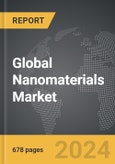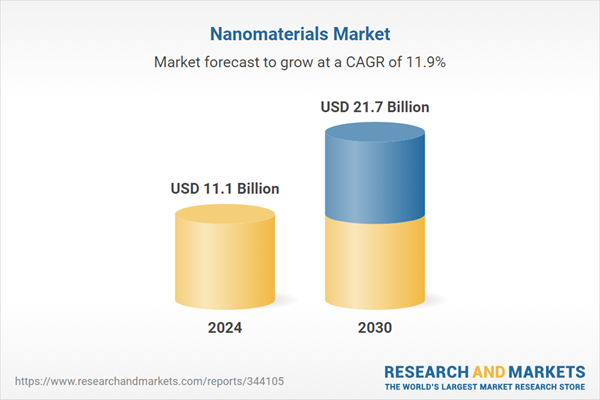The global market for Nanomaterials was valued at US$11.1 Billion in 2024 and is projected to reach US$21.7 Billion by 2030, growing at a CAGR of 11.9% from 2024 to 2030. This comprehensive report provides an in-depth analysis of market trends, drivers, and forecasts, helping you make informed business decisions. The report includes the most recent global tariff developments and how they impact the Nanomaterials market.
Recent trends in the development and application of nanomaterials highlight significant advancements in their synthesis, characterization, and integration into commercial products. Innovations in bottom-up and top-down fabrication techniques have allowed for greater control over the size, shape, and composition of nanomaterials, enabling the production of highly specialized materials tailored to specific applications. The use of nanomaterials in energy storage and conversion technologies, such as batteries, supercapacitors, and solar cells, has seen substantial growth, driven by the need for more efficient and sustainable energy solutions. Additionally, nanomaterials are increasingly being incorporated into environmental applications, such as water purification, air filtration, and waste management, due to their ability to effectively remove contaminants and pollutants. The development of multifunctional nanomaterials, which combine multiple properties or functions into a single material, is another emerging trend, offering new possibilities for innovation across various sectors.
The growth in the nanomaterials market is driven by several factors. Technological advancements in nanofabrication and characterization techniques have significantly enhanced the ability to produce and utilize nanomaterials in diverse applications, fostering widespread adoption. The increasing demand for high-performance materials in sectors such as electronics, healthcare, and energy is a major driver, as nanomaterials offer superior properties that meet the stringent requirements of these industries. Nanotechnology and nanoscience have witnessed significant growth in the recent years, led by the increasing availability and use of a range of tools and methods to synthesize nanomaterials. The innovative techniques of fabricating patterned nanostructures also is providing opportunities for improved computer modeling and simulation, while bio-medical, consolidated materials, dispersions and coating, and nanodevices represent a few new potential applications.
Government and private sector investments in nanotechnology research and development are also propelling market growth, with significant funding directed towards discovering new applications and improving manufacturing processes. Additionally, consumer behavior trends, such as the demand for smaller, more powerful electronic devices and the growing preference for sustainable and environmentally friendly products, are encouraging the use of nanomaterials. The expanding scope of nanotechnology in addressing global challenges, such as renewable energy and environmental remediation, further accelerates market growth. These factors collectively contribute to the robust expansion of the nanomaterials market, driving continuous innovation and integration into a wide array of products and applications.
Segments: Type (Carbon Nanotubes, Titanium Dioxide Nanoparticles, Silicon Dioxide, Aluminum Oxide Nanoparticles, Copper Oxide Nanoparticles, Other Types); Application (Medical, Electronics, Paints & Coatings, Energy & power, Other Applications).
Geographic Regions/Countries: World; USA; Canada; Japan; China; Europe; France; Germany; Italy; UK; Rest of Europe; Asia-Pacific; Rest of World.
The analysts continuously track trade developments worldwide, drawing insights from leading global economists and over 200 industry and policy institutions, including think tanks, trade organizations, and national economic advisory bodies. This intelligence is integrated into forecasting models to provide timely, data-driven analysis of emerging risks and opportunities.
Global Nanomaterials Market - Key Trends & Drivers Summarized
Nanomaterials are materials engineered at the nanoscale, typically less than 100 nanometers in size, exhibiting unique physical and chemical properties that differ significantly from their bulk counterparts. These materials include nanoparticles, nanotubes, nanofibers, and nanocomposites, each offering distinct advantages in various applications. Due to their high surface area to volume ratio, nanomaterials often exhibit enhanced mechanical strength, electrical conductivity, chemical reactivity, and optical properties. This makes them valuable in a wide range of industries, including electronics, healthcare, energy, and environmental science. In electronics, for example, nanomaterials are used to create smaller, faster, and more efficient devices. In healthcare, they enable advancements in drug delivery systems, imaging, and diagnostic tools, offering targeted treatments and improved patient outcomes.Recent trends in the development and application of nanomaterials highlight significant advancements in their synthesis, characterization, and integration into commercial products. Innovations in bottom-up and top-down fabrication techniques have allowed for greater control over the size, shape, and composition of nanomaterials, enabling the production of highly specialized materials tailored to specific applications. The use of nanomaterials in energy storage and conversion technologies, such as batteries, supercapacitors, and solar cells, has seen substantial growth, driven by the need for more efficient and sustainable energy solutions. Additionally, nanomaterials are increasingly being incorporated into environmental applications, such as water purification, air filtration, and waste management, due to their ability to effectively remove contaminants and pollutants. The development of multifunctional nanomaterials, which combine multiple properties or functions into a single material, is another emerging trend, offering new possibilities for innovation across various sectors.
The growth in the nanomaterials market is driven by several factors. Technological advancements in nanofabrication and characterization techniques have significantly enhanced the ability to produce and utilize nanomaterials in diverse applications, fostering widespread adoption. The increasing demand for high-performance materials in sectors such as electronics, healthcare, and energy is a major driver, as nanomaterials offer superior properties that meet the stringent requirements of these industries. Nanotechnology and nanoscience have witnessed significant growth in the recent years, led by the increasing availability and use of a range of tools and methods to synthesize nanomaterials. The innovative techniques of fabricating patterned nanostructures also is providing opportunities for improved computer modeling and simulation, while bio-medical, consolidated materials, dispersions and coating, and nanodevices represent a few new potential applications.
Government and private sector investments in nanotechnology research and development are also propelling market growth, with significant funding directed towards discovering new applications and improving manufacturing processes. Additionally, consumer behavior trends, such as the demand for smaller, more powerful electronic devices and the growing preference for sustainable and environmentally friendly products, are encouraging the use of nanomaterials. The expanding scope of nanotechnology in addressing global challenges, such as renewable energy and environmental remediation, further accelerates market growth. These factors collectively contribute to the robust expansion of the nanomaterials market, driving continuous innovation and integration into a wide array of products and applications.
Report Scope
The report analyzes the Nanomaterials market, presented in terms of units. The analysis covers the key segments and geographic regions outlined below.Segments: Type (Carbon Nanotubes, Titanium Dioxide Nanoparticles, Silicon Dioxide, Aluminum Oxide Nanoparticles, Copper Oxide Nanoparticles, Other Types); Application (Medical, Electronics, Paints & Coatings, Energy & power, Other Applications).
Geographic Regions/Countries: World; USA; Canada; Japan; China; Europe; France; Germany; Italy; UK; Rest of Europe; Asia-Pacific; Rest of World.
Key Insights:
- Market Growth: Understand the significant growth trajectory of the Carbon Nanotubes segment, which is expected to reach US$6.9 Billion by 2030 with a CAGR of a 13.3%. The Titanium Dioxide Nanoparticles segment is also set to grow at 12.3% CAGR over the analysis period.
- Regional Analysis: Gain insights into the U.S. market, valued at $2.7 Billion in 2024, and China, forecasted to grow at an impressive 13.5% CAGR to reach $2.0 Billion by 2030. Discover growth trends in other key regions, including Japan, Canada, Germany, and the Asia-Pacific.
Why You Should Buy This Report:
- Detailed Market Analysis: Access a thorough analysis of the Global Nanomaterials Market, covering all major geographic regions and market segments.
- Competitive Insights: Get an overview of the competitive landscape, including the market presence of major players across different geographies.
- Future Trends and Drivers: Understand the key trends and drivers shaping the future of the Global Nanomaterials Market.
- Actionable Insights: Benefit from actionable insights that can help you identify new revenue opportunities and make strategic business decisions.
Key Questions Answered:
- How is the Global Nanomaterials Market expected to evolve by 2030?
- What are the main drivers and restraints affecting the market?
- Which market segments will grow the most over the forecast period?
- How will market shares for different regions and segments change by 2030?
- Who are the leading players in the market, and what are their prospects?
Report Features:
- Comprehensive Market Data: Independent analysis of annual sales and market forecasts in US$ Million from 2024 to 2030.
- In-Depth Regional Analysis: Detailed insights into key markets, including the U.S., China, Japan, Canada, Europe, Asia-Pacific, Latin America, Middle East, and Africa.
- Company Profiles: Coverage of players such as Arkema Group, Cabot Corporation, Mitsubishi Gas Chemical Co., Inc., Kemira Oyj, Nanocyl SA and more.
- Complimentary Updates: Receive free report updates for one year to keep you informed of the latest market developments.
Some of the 233 companies featured in this Nanomaterials market report include:
- Arkema Group
- Cabot Corporation
- Mitsubishi Gas Chemical Co., Inc.
- Kemira Oyj
- Nanocyl SA
- Hyperion Catalysis International, Inc.
- Carbon Solutions, Inc.
- NanoCarrier Co., Ltd.
- Commonwealth Scientific and Industrial Research Organisation (CSIRO)
- Eikos, Inc.
- InMat, Inc.
- Nanobiotix
- Meliorum Technologies, Inc.
- Air Products Inc.
- China Metallurgical Information and Standardization Institute (CMISI)
Tariff Impact Analysis: Key Insights for 2025
Global tariff negotiations across 180+ countries are reshaping supply chains, costs, and competitiveness. This report reflects the latest developments as of April 2025 and incorporates forward-looking insights into the market outlook.The analysts continuously track trade developments worldwide, drawing insights from leading global economists and over 200 industry and policy institutions, including think tanks, trade organizations, and national economic advisory bodies. This intelligence is integrated into forecasting models to provide timely, data-driven analysis of emerging risks and opportunities.
What’s Included in This Edition:
- Tariff-adjusted market forecasts by region and segment
- Analysis of cost and supply chain implications by sourcing and trade exposure
- Strategic insights into geographic shifts
Buyers receive a free July 2025 update with:
- Finalized tariff impacts and new trade agreement effects
- Updated projections reflecting global sourcing and cost shifts
- Expanded country-specific coverage across the industry
Table of Contents
I. METHODOLOGYII. EXECUTIVE SUMMARY2. FOCUS ON SELECT PLAYERSIII. MARKET ANALYSISIV. COMPETITION
1. MARKET OVERVIEW
3. MARKET TRENDS & DRIVERS
4. GLOBAL MARKET PERSPECTIVE
UNITED STATES
CANADA
JAPAN
CHINA
EUROPE
FRANCE
GERMANY
ITALY
UNITED KINGDOM
REST OF EUROPE
ASIA-PACIFIC
REST OF WORLD
Companies Mentioned (Partial List)
A selection of companies mentioned in this report includes, but is not limited to:
- Arkema Group
- Cabot Corporation
- Mitsubishi Gas Chemical Co., Inc.
- Kemira Oyj
- Nanocyl SA
- Hyperion Catalysis International, Inc.
- Carbon Solutions, Inc.
- NanoCarrier Co., Ltd.
- Commonwealth Scientific and Industrial Research Organisation (CSIRO)
- Eikos, Inc.
- InMat, Inc.
- Nanobiotix
- Meliorum Technologies, Inc.
- Air Products Inc.
- China Metallurgical Information and Standardization Institute (CMISI)
Table Information
| Report Attribute | Details |
|---|---|
| No. of Pages | 678 |
| Published | April 2025 |
| Forecast Period | 2024 - 2030 |
| Estimated Market Value ( USD | $ 11.1 Billion |
| Forecasted Market Value ( USD | $ 21.7 Billion |
| Compound Annual Growth Rate | 11.9% |
| Regions Covered | Global |









